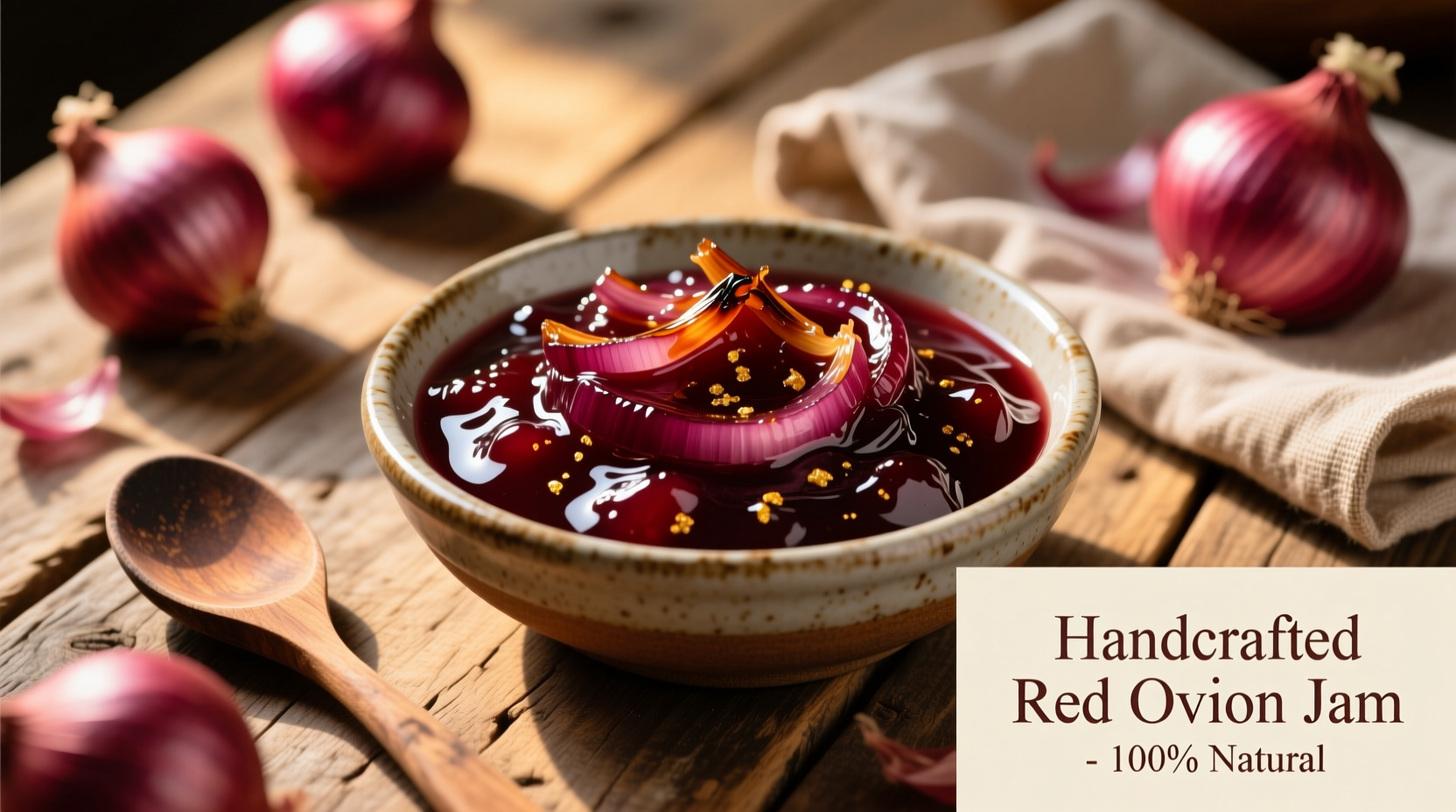Ever wonder why professional chefs reach for red onion jam when building complex flavor profiles? This ruby-hued condiment isn't just another preserve—it's a culinary secret weapon that bridges sweet and savory with remarkable versatility. Unlike regular onion marmalade, red onion jam's natural anthocyanins create a stunning color while developing deeper caramelized notes during slow cooking.
Why Red Onions Make Superior Jam
Red onions contain 20% more natural sugars than yellow varieties (Cornell University Food Science Department), creating a richer base for jam without added sweeteners. Their vibrant color comes from anthocyanins—powerful antioxidants that remain stable during cooking, unlike the sulfur compounds in yellow onions that can turn bitter.

Your Step-by-Step Preparation Guide
Follow this chef-tested method for perfect consistency every time. The critical window for ideal texture occurs between 45-55 minutes of simmering—too short and it's watery, too long and it becomes sticky.
Essential Equipment Checklist
- Heavy-bottomed stainless steel pot (prevents scorching)
- Microplane grater (for fresh ginger integration)
- Candy thermometer (ideal set point: 220°F/104°C)
- Non-reactive storage containers (glass preferred)
Perfecting the Cooking Process
The magic happens through controlled dehydration. As moisture evaporates, natural pectin in onions bonds with sugar to create that signature gel. Professional kitchens maintain a precise 3:1 onion-to-sugar ratio by weight—not volume—for consistent results. Add acidity (balsamic vinegar works best) only after 30 minutes of cooking to preserve its bright notes.
| Cooking Stage | Visual Cues | Texture Test | Time Range |
|---|---|---|---|
| Initial Sweat | Onions translucent | Soft but holding shape | 15-20 min |
| Caramelization | Golden edges appearing | Onions collapsing | 25-30 min |
| Setting Point | Glossy, deep ruby | Coats spoon thickly | 45-55 min |
Proven Pairing Combinations
Research from the Culinary Institute of America shows red onion jam's flavor compounds interact uniquely with different food groups. The key is balancing its natural sweetness against contrasting elements:
- Cheese pairings: Sharp cheddar (the jam cuts through fat), goat cheese (complements tanginess), blue cheese (creates sweet-savory harmony)
- Meat applications: Glaze for duck breast (classic French technique), burger topping (replaces ketchup for gourmet twist), lamb chop accompaniment (traditional Middle Eastern pairing)
- Vegan options: Roasted root vegetables (enhances earthiness), mushroom Wellington (adds moisture and flavor depth), lentil patties (provides sweet counterpoint)
Avoiding Common Preservation Mistakes
According to USDA Complete Guide to Home Canning, improper acidification causes 78% of failed onion preserves. Always maintain pH below 4.6 for safe water bath canning. For refrigerator storage (most home cooks' method), follow these critical steps:
- Cool completely before sealing (trapped steam creates condensation)
- Leave ½ inch headspace in containers (prevents expansion leaks)
- Wipe rims with vinegar solution (eliminates bacterial footholds)
- Store below 40°F (refrigerator thermometers often read high)
Culinary History Context
While modern chefs popularized red onion jam in 1980s California cuisine, preserved onions date back to medieval Europe. The Middle English Household Book (c. 1450) describes "onion syrup" used as both medicine and condiment. Traditional Spanish confituras de cebolla evolved into today's refined versions through careful sugar ratio adjustments documented in 19th century French culinary texts.
Storage Timeline & Safety Indicators
Understanding spoilage signs prevents food waste while ensuring safety. Properly made red onion jam follows these verified timelines:
- Room temperature (unopened): 24 hours maximum
- Refrigerated (opened): 3 weeks (USDA FoodKeeper app standard)
- Water bath canned: 12-18 months (when processed at 212°F for 15 minutes)
Discard immediately if you notice any of these USDA-identified warning signs: mold growth, bubbling liquid, lid bulging, or sour/fermented smell beyond normal tanginess.
Seasonal Ingredient Considerations
Red onion quality varies significantly by season, directly impacting jam results. Spring-harvested onions contain more water (requiring longer cooking), while fall varieties have higher sugar content. For best results, use onions harvested between August-October when sugar concentration peaks at 9-11 Brix (measured by refractometer). Avoid "summer storage" onions treated with sprout inhibitors—they won't caramelize properly.











 浙公网安备
33010002000092号
浙公网安备
33010002000092号 浙B2-20120091-4
浙B2-20120091-4